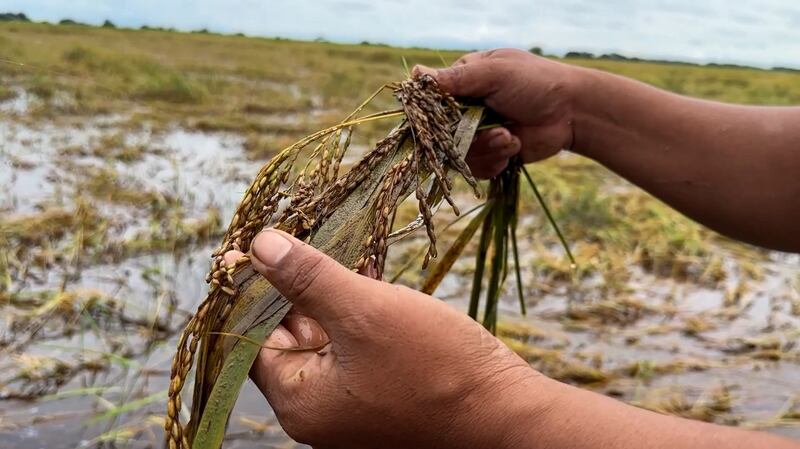Hundreds of thousands of acres of rice paddies have been destroyed amid flooding caused by heavy rains in southern Myanmar’s Bago region, according to residents, leaving the region’s farmers debt-ridden and struggling to stay afloat.
The devastation puts extra pressure on a sector of the population already reeling from junta economic mismanagement that has caused the kyat to tumble since the military’s February 2021 coup d’etat. International sanctions to punish the regime has added to the pain.
A deluge on the night of Oct. 8 caused the Bago River to rise around 1.2 meters (4 feet) above its critical level and flood the townships of Bago, Kawa, Daik-U and Thanatpin, farmers told RFA Burmese on Thursday.
The flooding – which caused chaos across five regions in total – prompted 13,000 people in Bago region alone to relocate to relief camps or Buddhist monasteries for shelter.
About 20 centimeters (8 inches) of rain fell in Myanmar over 24 hours — the highest level in nearly 60 years, according to the country’s Department of Meteorology and Hydrology. A dozen neighborhoods and seven villages across the region’s capital, Bago city, were inundated with water when the Bago River overflowed.
All rice-growing villages in the southern part of Bago city and to the east and west of the Bago River were inundated by the flooding, said a person providing assistance to farmers in the region and who, like others interviewed for this report, spoke on condition of anonymity, citing fear of reprisal.
“Thanatpin township lost about one-third [of its rice fields], and Kawa township also lost about one-third, so I believe that in the vicinity of Bago and Bago township, the loss will be hundreds of thousands of acres,” he said.
A farmer from the region told RFA that there are more than 2.8 million acres of farmland in the Bago region. He said around 50,000 of Kawa township’s 184,000 acres are likely to have been destroyed by the flooding.
In Thanatpin township, farmer Zaw Myo said he had lost at least 20 acres of farmland. He said that if he is unable to repay the debt he had taken on for this year’s crops, “I’ll go from being a farm owner to a farm laborer.”
“I made an investment in this farm by taking out an agricultural loan from the government,” he said. “Since my farm was submerged, I won’t be able to pay off my debt to the creditor.”
Unrealistic reference price
On Oct. 10, the Leading Body for Protection of Farmer Rights and Enhancement of Benefits, under Myanmar’s junta-appointed Ministry of Agriculture, Livestock and Irrigation, issued a statement saying that “100 baskets of clean rice [per acre] with 14% moisture is set as the reference price of 7.5 million kyats (US$3,570).”
But Wa Khaing, another farmer from Thanatpin, noted that because of soaring prices of fuel and fertilizer since the coup, the cost of sowing and harvesting one acre of farmland is as much as 800,000 kyats (US$380). That means the reference price set by the ministry “is not even enough to cover the capital expenditure.”
“When dealing with bad weather and floods, some farms may only be able to harvest a small percentage, which will result in a huge loss for the farmers,” he said.

Farmers told RFA that due to the flooding, they can only expect to harvest around 20% of their expected yield per acre.
San Koon, a 75-year-old farmer, noted that this is the second time this year that paddy fields in Bago were flooded, destroying the local rice crop.
“It’s painful for us farmers,” he said. “We lost all our investments after taking credit, so now I have run up a huge debt.”
About 30 of San Koon’s 50 acres of farmland was damaged by the flooding – the worst he’d seen in his lifetime of seasonal farming. He said he’s decided to give up farming entirely.
Translated by Htin Aung Kyaw. Edited by Joshua Lipes and Malcolm Foster.
